unit 2 sailing the oceans listening
文档属性
| 名称 | unit 2 sailing the oceans listening |  | |
| 格式 | rar | ||
| 文件大小 | 610.8KB | ||
| 资源类型 | 教案 | ||
| 版本资源 | 人教版(新课程标准) | ||
| 科目 | 英语 | ||
| 更新时间 | 2010-08-15 07:11:00 | ||
图片预览

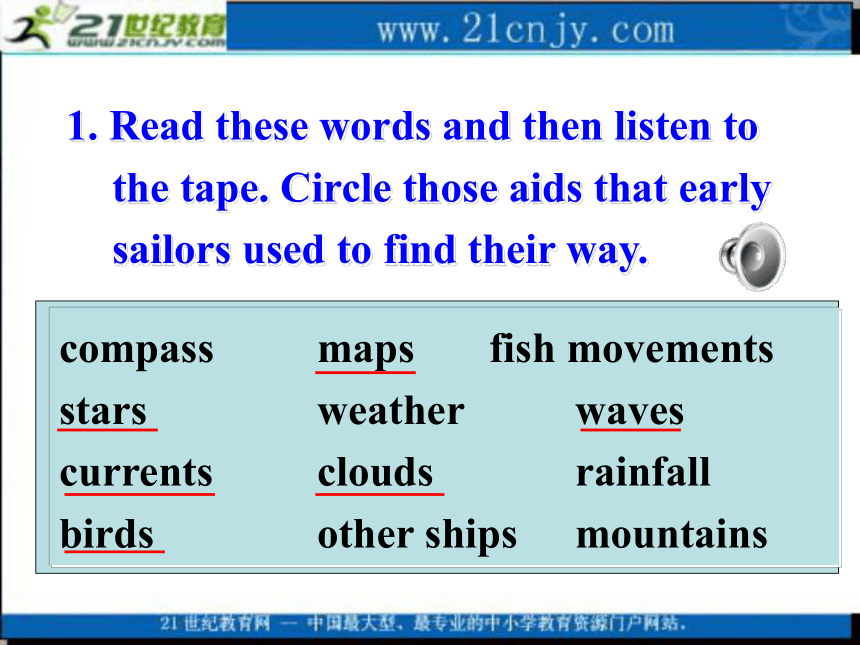
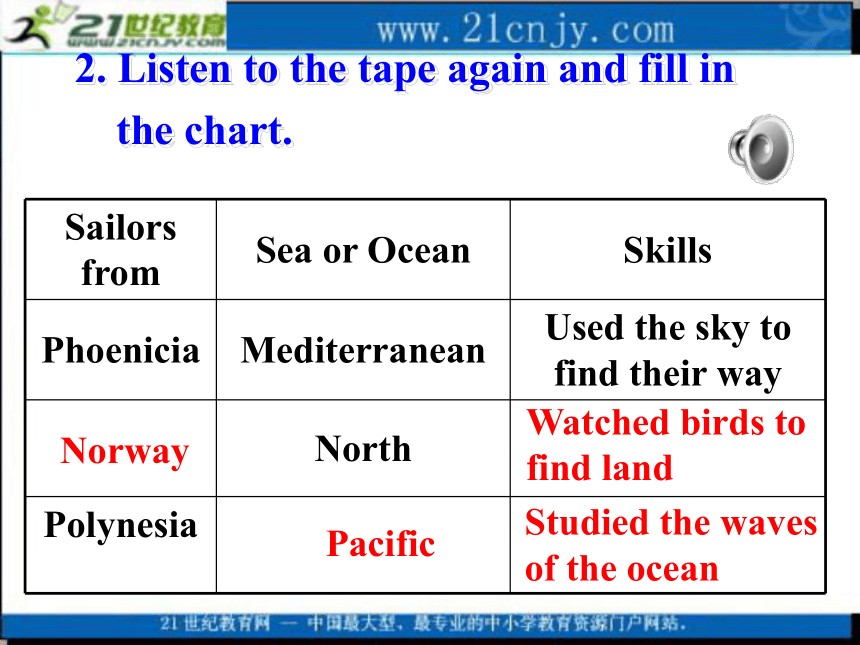

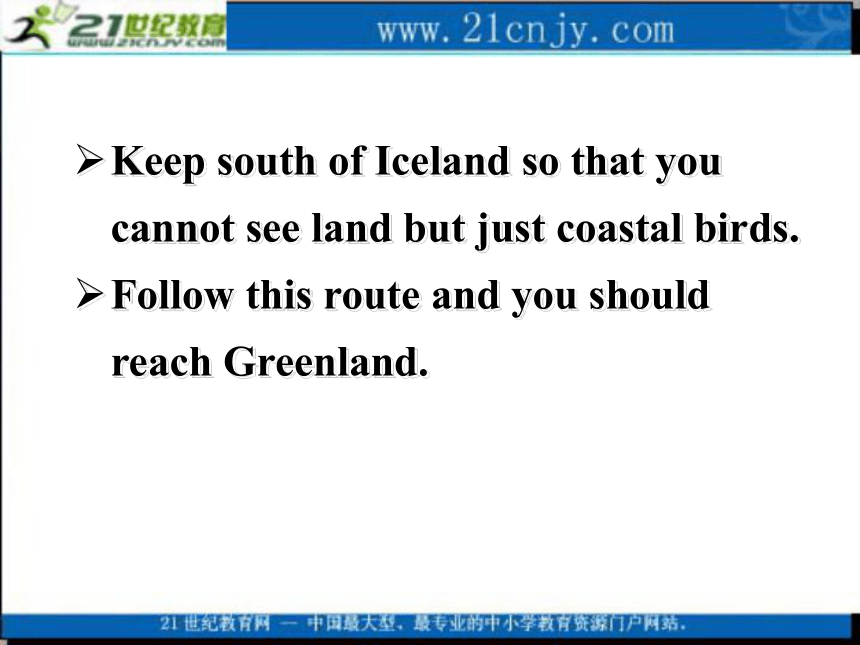
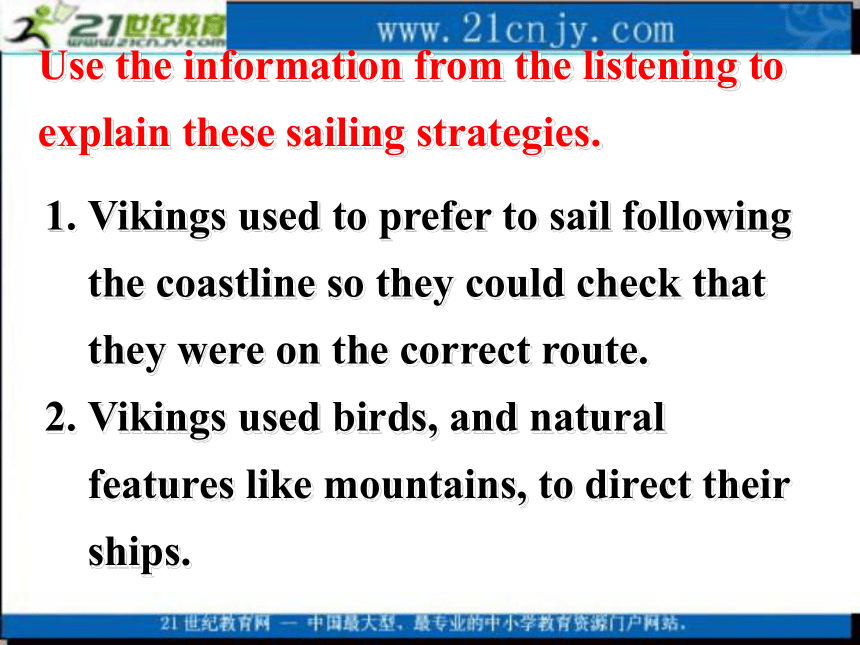

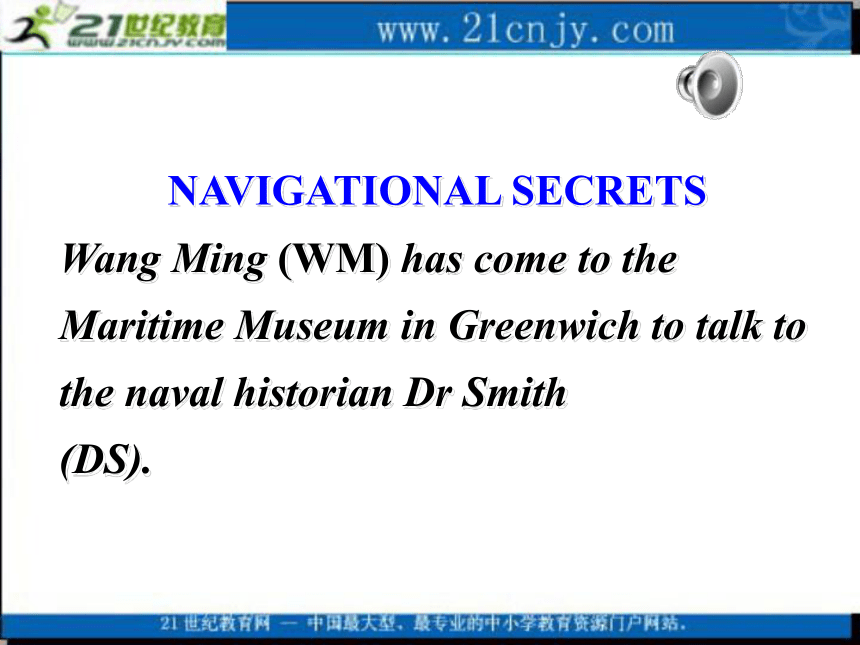
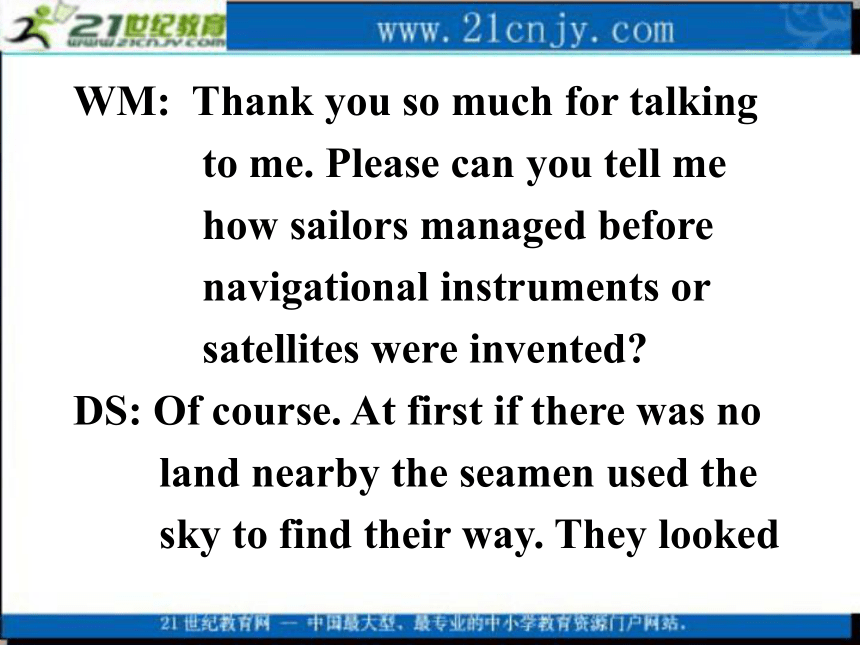
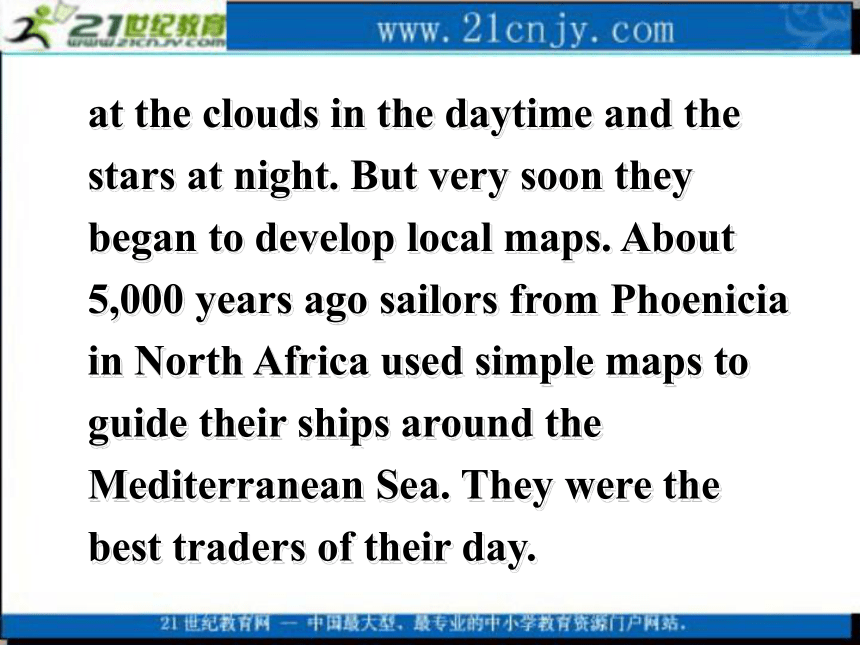
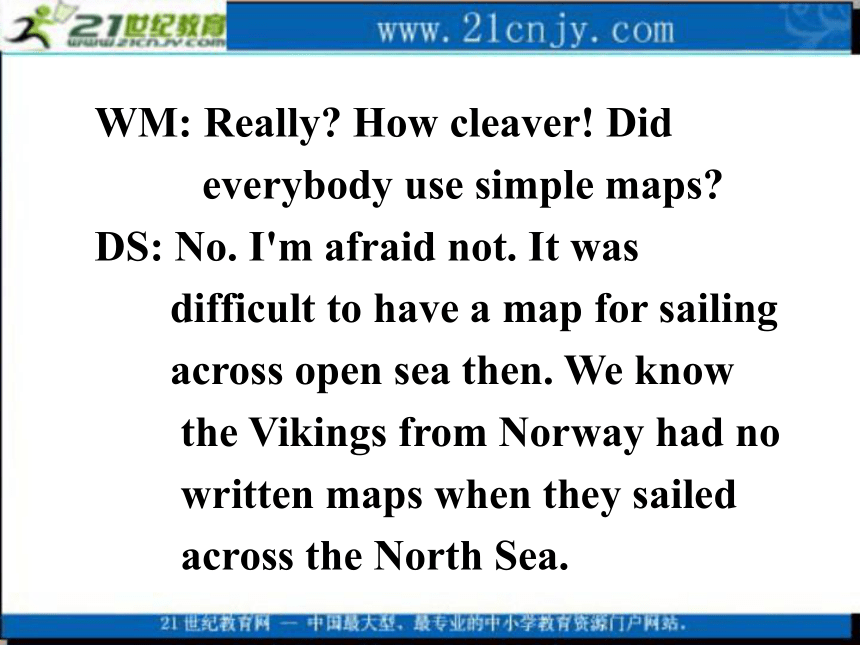

文档简介
课件34张PPT。Listening1. Read these words and then listen to the tape. Circle those aids that early sailors used to find their way.2. Listen to the tape again and fill in the chart.Norway Pacific Studied the waves of the ocean Watched birds to find land 3. These are some Viking sailing directions from Norway to Greenland.Sail west but keep to the north of the Shetland Islands so you can hardly see them in good weather.
Stay far enough south of the Faroes so that their steep mountains are just halfway up the horizon.Keep south of Iceland so that you cannot see land but just coastal birds.
Follow this route and you should reach Greenland.Use the information from the listening to explain these sailing strategies.Vikings used to prefer to sail following the coastline so they could check that they were on the correct route.
Vikings used birds, and natural features like mountains, to direct their ships. LISTENING TEXTNAVIGATIONAL SECRETS
Wang Ming (WM) has come to the Maritime Museum in Greenwich to talk to the naval historian Dr Smith
(DS).WM: Thank you so much for talking
to me. Please can you tell me
how sailors managed before
navigational instruments or
satellites were invented?
DS: Of course. At first if there was no
land nearby the seamen used the
sky to find their way. They looked at the clouds in the daytime and the stars at night. But very soon they began to develop local maps. About 5,000 years ago sailors from Phoenicia in North Africa used simple maps to guide their ships around the Mediterranean Sea. They were the best traders of their day.WM: Really? How cleaver! Did
everybody use simple maps?
DS: No. I'm afraid not. It was
difficult to have a map for sailing
across open sea then. We know
the Vikings from Norway had no
written maps when they sailed
across the North Sea.WM: The Vikings? Didn't they sail
around and attack people and
towns from their ships?
DS: Sometimes. But we're not
interested in that, only in their
superior sailing ability.
WM: I see! So what did they do?
DS: Well, one of the things they did
was concentrate on watchingbirds. There's the story of a Viking called Raven-Floki. He used to keep birds on his ships but he didn't feed them. Then when he thought land was near he'd let the birds go and if they flew straight to land, all he had to do was to follow them!WM: Did he find any new lands to
live on?
DS: Well, he did find a good way of
sailing from the Faroe Islands to
Iceland using his ravens. It’s said
that he took three birds on his
ship with him. When he’d been
sailing for a day or two towards
Iceland he let the first bird go. It flew back to the Faroe Islands. A day after this he let the second bird go. This flew out of sight but came back to rest on the ship. Sometime after that, he let the third bird go. It headed straight for Iceland so Raven-Floki followed it and arrived there safely. WM: That sounds clever! I’ve heard
too about the Polynesians in the
Pacific Ocean. They did some
amazing voyages without any
navigational instruments to help
them at all. How did they do that?
DS: Nobody’s really quite sure. But it seems that they studied the
currents in the water, the colour
of the sea and the different kinds
of waves.
WM: Do Polynesian sailors still do that?
DS: Not nowadays I’m afraid.
WM: Have we lost this skill?DS: Yes, I'm afraid we have. Ancient
Polynesians made maps of leaves and shells which others were able to follow. If only we could read them we would be able to understand more of their navigational skills. The sailors from Phoenicia, Norway and Polynesia could certainly teach
us a lot. ( fade out)Listening on P59 Zheng He sailed from
China to many places
throughout South Pacific,
Indian Ocean, Taiwan,
Persian Gulf and distant
Africa in seven epic voyages from 1405 to 1433 ,some 80 years before Columbus's voyages. 1. What places might he visit?
2. What did he bring back?
3. Why did he set off the voyages?
4. Why didn’t the Emperor continue this
policy?
5. Why is he so important in the history? Pre-listening Listen to the tape and tick those ports and islands mentioned in the text.Exercise 3No reports of other navigators for this period have survived.It was written in documents.The writers mention it in the books.He made 7 voyages and visited more than 30 countries.Zheng He remarks how much the foreign kings liked porcelain and silk.1. He brought a giraffe for the Emperor from Africa. 2. He brought scarves of fine gold decorated with pearls and precious stones. Exercise 4The Emperor wanted to demonstrate
Chinese power abroad so ______________________________________________________________________________
2. When he died Zheng He wanted people
to know how successful he had been so _____________________________________________he sent Zheng He with a large fleet of
ships to visit new places in neighbouring countries. he put up a pillar describing all his achievements.3. The writers wanted people to believe
that Zheng He’s ships were large so
__________________________________________________________________________________________
4. The writers wanted people to believe
Zheng He was very important so
_________________________________
________that they would believe that he really had achieved great things and gone to many foreign countries.they described him as being eight feet tall.Listening textWho Was Zheng He? (Li Huaying =LH, Celia Main=CM)LH: The most famous Chinese navigator
was Zheng He lived from 1371 to
1433 and made seven voyages
around the South China Sea, across
to India and even as far as the
eastern coast of Africa. It was 600th anniversary of these voyages in
2005.
CM: Are there other famous Chinese
navigators or is he only one?
LH: He is the only one we’ve got
evidence for.
CM: So there may have been others?
LH: We don’t know. That’s because a
later Emperor may have destroyed
a lot of evidence of other voyages. CM: I see. Where did Zheng He go?
LH: The documents tell us that he was
born in Yunnan. He built a pillar to
record his achievements. It states
that he made seven voyages and
visited more than thirty countries.
He said that the Emperor ordered
him to show the strength of Chinese
power and meet “foreigners from
beyond the seas”. So he went to unknown places and set up trade.
CM: Tell me about his Voyages.
LH: Well, on his first voyage he
visited Calicut in India. The people
there were very impresses and a
little frightened when they saw so
many large ships. So the ruler
wisely decided to make friends with
these strangers. He gave Zheng He many scarves made of gold and
decorated with jewels. Then he
entertained him and his men with
music and songs.
CM: Did he go to other places?
LH: Yes, on other voyages he visited
Champa, and Sumatra near China,
Hormuz, and Aden in the Persian
Gulf and Mogadishu in Africa.
Zheng He opened diplomatic
relations with them and gave them presents.
CM: What did Chinese offer as gifts?
LH: Zheng He found that foreign kings
particularly admired Chinese
porcelain and silk. So that’s why his
ships were filled with those things.
CM: I see. Is that why they say his ships
were so large?
LH: Yes, I suppose so. When he
returned from India he brought a giraffe for the Emperor as a
present. So his ships must have
been large.
CM: Some writers say that the ships
could carry as many as
20,000people altogether.
LH: And other writers say Zheng He
was 8 feet tall! We shouldn’t
believe everything writers tell us.
Obviously they wanted to show how important Zheng He was.
Undoubtedly the ships were
large--- but perhaps not that
large!
CM: I see. That makes sense. Well,
thank you for telling me about
Zheng He. He sounds a
fascinating man.
Stay far enough south of the Faroes so that their steep mountains are just halfway up the horizon.Keep south of Iceland so that you cannot see land but just coastal birds.
Follow this route and you should reach Greenland.Use the information from the listening to explain these sailing strategies.Vikings used to prefer to sail following the coastline so they could check that they were on the correct route.
Vikings used birds, and natural features like mountains, to direct their ships. LISTENING TEXTNAVIGATIONAL SECRETS
Wang Ming (WM) has come to the Maritime Museum in Greenwich to talk to the naval historian Dr Smith
(DS).WM: Thank you so much for talking
to me. Please can you tell me
how sailors managed before
navigational instruments or
satellites were invented?
DS: Of course. At first if there was no
land nearby the seamen used the
sky to find their way. They looked at the clouds in the daytime and the stars at night. But very soon they began to develop local maps. About 5,000 years ago sailors from Phoenicia in North Africa used simple maps to guide their ships around the Mediterranean Sea. They were the best traders of their day.WM: Really? How cleaver! Did
everybody use simple maps?
DS: No. I'm afraid not. It was
difficult to have a map for sailing
across open sea then. We know
the Vikings from Norway had no
written maps when they sailed
across the North Sea.WM: The Vikings? Didn't they sail
around and attack people and
towns from their ships?
DS: Sometimes. But we're not
interested in that, only in their
superior sailing ability.
WM: I see! So what did they do?
DS: Well, one of the things they did
was concentrate on watchingbirds. There's the story of a Viking called Raven-Floki. He used to keep birds on his ships but he didn't feed them. Then when he thought land was near he'd let the birds go and if they flew straight to land, all he had to do was to follow them!WM: Did he find any new lands to
live on?
DS: Well, he did find a good way of
sailing from the Faroe Islands to
Iceland using his ravens. It’s said
that he took three birds on his
ship with him. When he’d been
sailing for a day or two towards
Iceland he let the first bird go. It flew back to the Faroe Islands. A day after this he let the second bird go. This flew out of sight but came back to rest on the ship. Sometime after that, he let the third bird go. It headed straight for Iceland so Raven-Floki followed it and arrived there safely. WM: That sounds clever! I’ve heard
too about the Polynesians in the
Pacific Ocean. They did some
amazing voyages without any
navigational instruments to help
them at all. How did they do that?
DS: Nobody’s really quite sure. But it seems that they studied the
currents in the water, the colour
of the sea and the different kinds
of waves.
WM: Do Polynesian sailors still do that?
DS: Not nowadays I’m afraid.
WM: Have we lost this skill?DS: Yes, I'm afraid we have. Ancient
Polynesians made maps of leaves and shells which others were able to follow. If only we could read them we would be able to understand more of their navigational skills. The sailors from Phoenicia, Norway and Polynesia could certainly teach
us a lot. ( fade out)Listening on P59 Zheng He sailed from
China to many places
throughout South Pacific,
Indian Ocean, Taiwan,
Persian Gulf and distant
Africa in seven epic voyages from 1405 to 1433 ,some 80 years before Columbus's voyages. 1. What places might he visit?
2. What did he bring back?
3. Why did he set off the voyages?
4. Why didn’t the Emperor continue this
policy?
5. Why is he so important in the history? Pre-listening Listen to the tape and tick those ports and islands mentioned in the text.Exercise 3No reports of other navigators for this period have survived.It was written in documents.The writers mention it in the books.He made 7 voyages and visited more than 30 countries.Zheng He remarks how much the foreign kings liked porcelain and silk.1. He brought a giraffe for the Emperor from Africa. 2. He brought scarves of fine gold decorated with pearls and precious stones. Exercise 4The Emperor wanted to demonstrate
Chinese power abroad so ______________________________________________________________________________
2. When he died Zheng He wanted people
to know how successful he had been so _____________________________________________he sent Zheng He with a large fleet of
ships to visit new places in neighbouring countries. he put up a pillar describing all his achievements.3. The writers wanted people to believe
that Zheng He’s ships were large so
__________________________________________________________________________________________
4. The writers wanted people to believe
Zheng He was very important so
_________________________________
________that they would believe that he really had achieved great things and gone to many foreign countries.they described him as being eight feet tall.Listening textWho Was Zheng He? (Li Huaying =LH, Celia Main=CM)LH: The most famous Chinese navigator
was Zheng He lived from 1371 to
1433 and made seven voyages
around the South China Sea, across
to India and even as far as the
eastern coast of Africa. It was 600th anniversary of these voyages in
2005.
CM: Are there other famous Chinese
navigators or is he only one?
LH: He is the only one we’ve got
evidence for.
CM: So there may have been others?
LH: We don’t know. That’s because a
later Emperor may have destroyed
a lot of evidence of other voyages. CM: I see. Where did Zheng He go?
LH: The documents tell us that he was
born in Yunnan. He built a pillar to
record his achievements. It states
that he made seven voyages and
visited more than thirty countries.
He said that the Emperor ordered
him to show the strength of Chinese
power and meet “foreigners from
beyond the seas”. So he went to unknown places and set up trade.
CM: Tell me about his Voyages.
LH: Well, on his first voyage he
visited Calicut in India. The people
there were very impresses and a
little frightened when they saw so
many large ships. So the ruler
wisely decided to make friends with
these strangers. He gave Zheng He many scarves made of gold and
decorated with jewels. Then he
entertained him and his men with
music and songs.
CM: Did he go to other places?
LH: Yes, on other voyages he visited
Champa, and Sumatra near China,
Hormuz, and Aden in the Persian
Gulf and Mogadishu in Africa.
Zheng He opened diplomatic
relations with them and gave them presents.
CM: What did Chinese offer as gifts?
LH: Zheng He found that foreign kings
particularly admired Chinese
porcelain and silk. So that’s why his
ships were filled with those things.
CM: I see. Is that why they say his ships
were so large?
LH: Yes, I suppose so. When he
returned from India he brought a giraffe for the Emperor as a
present. So his ships must have
been large.
CM: Some writers say that the ships
could carry as many as
20,000people altogether.
LH: And other writers say Zheng He
was 8 feet tall! We shouldn’t
believe everything writers tell us.
Obviously they wanted to show how important Zheng He was.
Undoubtedly the ships were
large--- but perhaps not that
large!
CM: I see. That makes sense. Well,
thank you for telling me about
Zheng He. He sounds a
fascinating man.
